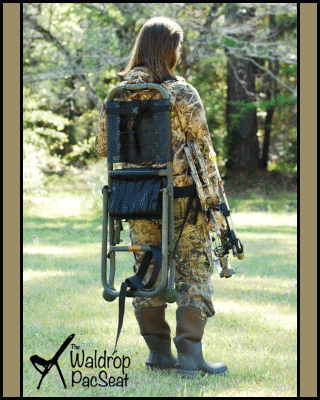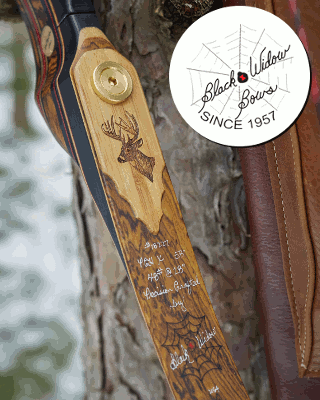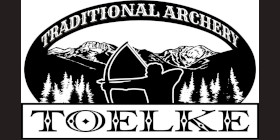http://shakespearearchery.blogspot.com/2013/04/ernie-root-by-lawrence-root.html A Son's Memory of His Father-
Ernie Root By Lawrence Root
My name is Lawrence (Larry) Root and I am the son of Ernie and Marcy Root, the founders, owners and operators of Root Archery and several other related corporations. I am the last surviving member of the Root family and, at age 65, would like to contribute to the knowledge-base for my family's businesses. I have seen many posts asking questions about Root Archery. I would be happy to fill in whatever blanks that I can. Unfortunately, there are very few surviving records, such as yearly production, serial- number ranges, when production went fully to Shakespeare, etc. I do have some records I can access as well as one surviving employee I keep in touch with who was also a member of the Root Archery team.
Root Archery started in my family's basement in suburban Chicago. After outgrowing a couple of small buildings in the area my parent's decided to move out of the city, eventually settling in Big Rapids, MI where I still live. I did not pursue archery for many reasons. Dad tried to teach me to shoot, but since it was so natural to him (he was a champion-level tournament archer) he really couldn't teach me how to shoot. Our practice sessions ended when I was quite young. I studied business in college, the assumption being that I would eventually take over the business. I actually began working in the business at age 14, working in the factory starting at age 16 (which was legal as it was a family business). The business was sold to Shakespeare in 1969 and moved to Shakespeare's Columbia, SC facility approximately three years later. I finished my business degree and stayed on with Shakespeare until the move. I left the company when my duties regarding assisting with the move were complete. It was tough going into Dad's office to tell him I was done with my work. I chose to go to law school and in 1976 was elected, at age 28, to serve as the Circuit Judge in my home area of Michigan. I served on the bench for nearly three decades, retiring from the bench in 2005. I now run a law practice limited to alternative dispute resolution services such as serving as an arbitrator or mediator.
The selling of the business was a well-disguised blessing. Root Archery was Ernie Root and he it. It's successful operation depended on him and his knowledge base, both in the design and manufacturing arena as well as on the marketing side. Shakespeare found this out when they moved the operation to SC against the advice of Dad and several key people at Shakespeare. Dad had a five-year management contract as part of the sale of the business, but insisted that it contain a term that he need not be forced to perform his duties out of the State of Michigan. He refused to move to SC, so Shakespeare was left to operate the business without Dad's expertise or assistance. It didn't go well...
Our first operations in Michigan were indeed in Rogers Heights, a few miles south of Big Rapids. We had two locations there, plus a small shop in Big Rapids where Precision Bow Strings, my mother's side of the businesses, was located.
To help understand the divisions, there were actually three corporations behind the Root Archery brand. Bow Blanks, Inc. handled the early production steps, making the "sandwich" from which a bow is made. The handle, was roughed, but feathered. The maple laminations were cut and tapered. The appropriate fiberglass was chosen, then they were all assembled, glued up and put into a press that used air pressure to hold everything in a form for that particular model. The sandwich (my term) was then heated and the glue cured. Once it was done, it was removed and carefully placed on a cart with racks to hold the assembly horizontal. On cooling the rough bow was ready to move on.
Bow Crafters, Inc., was the operation that took the Bow Blanks and did the detail work to form the finished bow. This involved a lot of hand working. The bows were strung, their straightness verified and their draw weights checked. Final finishing involved them being sprayed with the finish of the era. They were then ready to go out to fill orders.
Root Archery, Inc. was actually the marketing arm of the business. Archery Research was set up later to handle the development of the Golden Eagle, it's manufacturing (on essentially the same lines as the Root Bows) and marketing.
One plant in Rogers Heights was dedicated to Bow Blanks. The other was Bow Crafters and Root Archery.
Eventually all three were combined into one plant in Big Rapids, but I'll have to research when that occurred. Archery Research came in the Big Rapids time frame. Precision Bow Strings stayed it its separate location in Big Rapids. In fact, it wasn't sold to Shakespeare, but rather PSE, Inc., about the same time as the sale of Root Archery.
OK, to address the questions:
Root Archery made Shakespeare bows, as well as other private-branded bows, at the same time and on the same production lines as Root Bows. That continued until Shakespeare moved the factory to SC, although they really owned the operation from the date of the sale in 1969 on. The move was around 1971...
It's my understanding, based on what I've been told by a couple of our former employees that went to SC with the equipment, that Jeffrey bought almost all of the equipment. If so, they have some really great equipment. Shakespeare may have bought a few pieces of equipment, but the heart of the operation was our equipment. Dad kept, and I still have, Root Archery piece of equipment #1m an old bandsaw. It still has the numeral "1" stencil on it. Still works too :-)
As a side note, Dad told me that the guy who moved to Big Rapids with us when the operation moved from suburban Chicago in 1955, Bill Ramsey, made Dad a set of the patterns Dad himself used for his bows. I've not looked through them, but they are in my garage attic (if you saw that attic you'd see why I haven't dug them out). There are also a few of the really early bows in varying stages of completion. I'm concerned that the heat of many summers may have degraded the old bows. I'd have to check out the status of the Root Archery logo and business name, but I occasionally think it'd be great if someone (not me) put those old patterns to use...
Who came up with the Root Archery logo, a rustic- stylized rendition of my last name, Root? The answer is that Dad designed that logo and came up with the immodest marketing phrase "Fabulous Root Bow". While Dad wasn't a sentimentalist, he also wasn't known to be overly modest. I write that with fondness. Dad was good (great) at what he did and knew it...
Shakespeare did offer a number of our employees the option of moving with the operation to Columbia, and a few did go. By name (from a memory famously weak in the remembering-names category), they were Bill Ramsey, "Sam" Forrest Samuleson and Jim Obert. I don't know any of these by the nickname "shorthair", but a couple of these guys could have qualified for that description.
I'll fill in some blanks in later posts and I would like to answer questions and emails within reason.
I want to provide as much detail as I can in a series of posts, a process that will likely unfold over time as I recall information, discover such from what I do have in family records and learn from former Root Archery employees.
http://shakespearearchery.blogspot.com/2012/09/normal-0-false-false-false-en-us-x-none.html the Short History of Shakespeare / Root Archery 1959-1976 (with help by George D Stout, Rick Rappe, Lawrence Root and Bob Hargreaves))
The Short History of Root and Shakespeare Archery, 1959- 1976
The history of Shakespeare Archery has been neglected. Shakespeare stopped archery production in 1976 and the company lost their records over the years. Recently Ernie Roots son, Lawrence Root, has stepped forward and added valuable information.
William Shakespeare, Jr. invented a patent for his fishing reel, and began producing fishing equipment in the late 1800's. In the 20th century Shakespeare became a major producer of sporting equipment. In 1959 Shakespeare Cooperation acquiring Parabow the Ohio-based Parallel Products Company, a maker of archery equipment that was organized into Shakespeare's Archery subsidiary. Parabow was one of the main producers of solid fiberglass bows in the 1950. Shakespeare was an early pioneer of the application of fiberglass to fishing rods. The merger of these two companies was a match made in heaven. During the sixties and seventies Shakespeare produce fiberglass and wood laminate bow but it did not forsake its Parabow line of solid fiberglass archery equipment.
RH and LH Model 100-600 1959 and 1960
The style of these bow were simple and they were often the first bow of a youngster. In 1959, along with the Parabow line, Shakespeare introduced the 100 through 400 series of recurves. In the early 1960 Shakespeare began collaboration with a gifted bow maker Ernie Root.
Ernie Root
Shakespeare partnered with Mr. Root and together they created outstanding and affordable bows. Root Archery started as a family business in suburban Chicago. After outgrowing a couple of small spaces it move out of the city, eventually settling in Big Rapids, MI. Ernie Root was a great tournament archer and set a record for individual score of 836 in 1947 which was not broken until 1959.
One of the few online photos of Ernie Root (second from right)
Most people assumed that Shakespeare acquired Root Archery in the late 1960’s. Ernie root’s Son Lawernce Root has been adding to the knowledge and now it seems that it was a mutual beneficial merger rather than an acquisition. Root Archery had been a supplier to Shakespeare for a number of years. Ernie Root made his bows, from the early 50's to the late 60's or early 70's in Big Rapids, MI. Around the late 60's he sold a number of his designs to Shakespeare, who slimmed them down and renamed them. For example: The Root Warrior became the Necedah in 1964 as a 55”bow, and The Brush Master became the Kaibab, the Field Master became the Ocala. The first bows of this type bore the name "Root, by Shakespeare". Shortly afterwards Ernie Root went to work for Shakespeare, and the Root name was dropped completely but his design influence would continue. After the merger to Shakespeare, Mr. Root was became consultant and manager production. Ernie was also continued producing his own line of bows under the "ROOT" name even though the business was sold to Shakespeare in 1969. Shakespeare moved to Columbia, SC approximately three years later, a move Mr. Root opposed.
after leaving Shakespeare Ernie dedicate his time to the Golden Eagle with Phil Grable
Golden Eagle was an extension of Root's Archery Research Division
Owen Jeffery in 1974 Shakespeare Catalog
Shakespeare continued without Ernie Root which adversely effected quality and production. Ernie devoted his time to developing the metal riser take-down (Golden Eagle) with Phil Grable (Owen Jeffery later took over the design of the bow with Jeffery Archery).
Owen Jeffery, an inventive and talented bowyer was hire as President of Shakespeare Archery to revitalize the brand. Before He came to Shakespeare he was Master Bowyer and a Vice-President at Bear Archery. He brought Shakespeare's Archery operation in Columbia South Carolina. Later he began Jeffery Archery around 1975. Shakespeare, Bear, and Pearson were the three most widely sold brands in the country. They built and sold a lot of bows throughout the sixties and specialized in solid performers for reasonable prices. Shakespeare never totally grasped the changing landscape of 1970's bow production, Shakespeare clung to the recurve bow while other manufacturers embraced the compound. Shakespeare closed the line of archery equipment in 1976. Shakespeare's Archery division was only part of the Shakespeare Corporation and they decided to get out of the archery field when it became apparent that the market was headed to the development of the compound bow. They never produced compounds but did create prototypes. If you run across a Shakespeare compound bow it is one of a kind, a true collector.
Many of Shakespeares bow designs were sold to Proline such as the Shakespeare Osprey, Condor and Golden Eagle. Often both logos appeared on the bows. Eventually an "S" appeared before "Proline". Proline stopped making recurves and adopted the compound trend. Proline went out of business in the early 1990s.
Bob Hargreaves send photos of the building which once housed the Root factory. He says the front of the building has changed over the years but the rest is very similar to the old days.
. It was very plain looking back then and there were parking spaces all
across the front. The spaces on each side of the front door were reserved for
Ernie and Dave.
East side of building.
Rear view. The Quonset hut on the left is where all wood was stored.
Rear of building. This was the finishing area.
Marcy Root's string factory was on this alley in downtown Big Rapids.
try to imagine Bear Archery without Fred Bear!!
So why did Shakespeare Archery
fail and Bear Archery prosper? One obvious reason was Fred Bear. With his distinctive hat, Fred Bear was a celebrity, an archery innovator and icon. He had the perfect name too. Image if his name had NOT not been "Bear"? Imagine a Fred Lamb, a Fred Dangerfield, or a Fred Smith Bow? It just doesn't sound the same. Bear archery succeeded because of Fred Bear. He was the guiding force behind the company. Bear Archery is one of the oldest archery companies so Shakespeare had to play catch-up to Bear. This was a friendly competition however. Fred Bear and Ernie Root were good friends. They often shared materials and equipment and help each other out. By the Mid to late 1960s Shakespeare was producing bows that equaled Bear in quality and speed. The compound bow was the "beginning of the end" for Shakespeare. Around the time of it's appearance Mr. Root was leaving Shakespeare and their Archery Division was in turmoil. However Bear Archery began investing in the new technology and reinvented itself and Bear never dropped the recurve bow from it's line. So, nearly forty years later, Shakespeare Archery is a memory while Bear still produces quality bows. There are many more Bear bows than Shakespeare / Root Bows available to a vintage collector today. Real vintage collectors acknowledge Ernie Root as a brilliant bowyer equal in skill to Fred Bear. Even the most ardent Bear fan grudging respects the Shakespeare / Root bows. I own Hoyt, Bear, York, Groves, Pearson, and Shakespeare Bows. Personally I love the look and feel of the Shakespeare Bow. I know from experience that they are equal in beauty to the Bear bow and in a speed test, they are more than equal to a Bear as well.




















